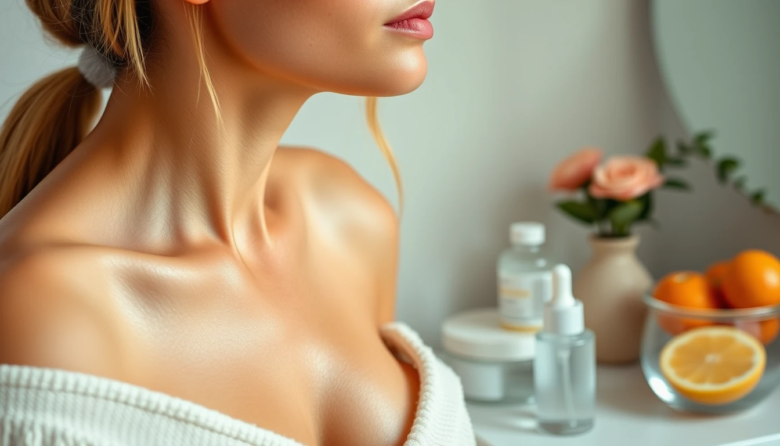Introduction
Achieving radiant, healthy skin is not merely a matter of using the right skincare products—it’s about embracing a holistic lifestyle that supports your skin from the inside out. Many people struggle with common skin concerns like cellulite and loss of elasticity, which can affect not only appearance but also self-confidence. Fortunately, there are lifestyle changes you can make that not only combat these issues but also promote overall skin vitality.
In this guide, we explore evidence-based lifestyle strategies that help reduce the appearance of cellulite and boost skin elasticity. Our approach combines nutritional insights, effective hydration, regular physical activity, stress management, quality sleep, and a consistent skincare routine. In Part 1, we will establish a foundational understanding of skin health, examine the biological factors contributing to cellulite and stretch marks, and detail the daily habits that can improve your skin’s resilience. Part 2 will then delve deeper into advanced skincare routines, personalized adjustments, and additional preventive measures for long-term skin health.
By integrating these healthy habits into your daily routine, you can significantly improve your skin’s appearance and maintain a youthful, vibrant glow. Let’s begin our journey to understanding the keys to healthy skin.
Understanding Skin Health
The Anatomy and Function of Healthy Skin
The skin is the body’s largest organ and serves as a protective barrier against environmental stressors. It comprises three main layers:
- Epidermis: The outermost layer, responsible for protecting against pathogens and physical damage.
- Dermis: The middle layer, which contains collagen and elastin fibers that provide structure, firmness, and elasticity.
- Subcutaneous Tissue: The deepest layer, made primarily of fat cells, which cushion and insulate the body.
Healthy skin relies on the strength and integrity of collagen and elastin fibers. These proteins help the skin retain its firmness and bounce, and their degradation over time—due to aging, environmental factors, or lifestyle choices—can lead to the appearance of cellulite and reduced skin elasticity.
How Cellulite and Stretch Marks Form
Cellulite is characterized by a dimpled, uneven appearance of the skin, often found on the thighs, buttocks, and abdomen. It results from the interaction between fat cells and the connective tissue (septae) in the subcutaneous layer. When fat cells expand, they push against the skin, while stiff connective tissues create an uneven surface.
Stretch Marks (striae) form when the skin is stretched too rapidly. The sudden expansion can cause collagen and elastin fibers in the dermis to tear, resulting in linear scars. These marks usually start as red or purple lines and fade to a white or silvery color over time.
Understanding these processes is crucial because it highlights that both conditions are influenced by factors beyond just topical treatments—they are deeply connected to your overall lifestyle and skin health.
Lifestyle Factors Influencing Skin Health
A holistic approach to skin health considers the cumulative impact of nutrition, hydration, physical activity, stress management, and sleep. Each of these factors plays a significant role in maintaining the structure and function of your skin.
Nutrition and Hydration
Diet for Skin Resilience
- Nutrient-Rich Foods:
A balanced diet rich in vitamins A, C, and E, as well as minerals and antioxidants, supports collagen production and skin repair. Foods such as leafy greens, berries, citrus fruits, nuts, and fish provide the building blocks for healthy skin. - Anti-Inflammatory Benefits:
An anti-inflammatory diet, which limits processed foods and sugars, can help reduce inflammation—a key factor in the degradation of collagen and elastin. Incorporate whole grains, lean proteins, and healthy fats (like those found in olive oil and avocados) to promote a balanced inflammatory response.
Importance of Hydration
- Maintaining Skin Elasticity:
Water is essential for maintaining the skin’s moisture balance. Adequate hydration helps keep the skin plump, reduces the appearance of fine lines, and supports the natural repair processes. - Practical Hydration Tips:
Aim to drink at least eight glasses of water daily. Complement this with hydrating foods such as cucumbers, watermelon, and oranges to boost your overall water intake.
Physical Activity and Exercise
Benefits of Regular Exercise
- Improved Circulation:
Regular physical activity enhances blood flow, ensuring that essential nutrients and oxygen reach your skin cells, promoting repair and regeneration. - Muscle Tone and Skin Support:
Building muscle tone, especially in areas prone to cellulite, can help smooth out the skin’s appearance. Exercises like squats, lunges, and resistance training strengthen underlying muscles, reducing the visible effect of fat deposits. - Weight Management:
Consistent exercise helps maintain a healthy weight, which is crucial for preventing rapid fat accumulation that can strain the skin and lead to stretch marks.
Stress Management and Quality Sleep
Impact of Stress on Skin Health
- Hormonal Influence:
Chronic stress increases cortisol levels, which can break down collagen and lead to skin thinning. This hormonal imbalance may exacerbate the appearance of cellulite and stretch marks. - Stress Reduction Techniques:
Engage in activities such as yoga, meditation, or deep-breathing exercises to lower stress levels. Regular practice of these techniques can help stabilize hormones and promote overall well-being.
Importance of Sleep
- Skin Repair and Regeneration:
During sleep, the body repairs and regenerates skin cells. A consistent sleep schedule of 7-9 hours per night is crucial for maintaining skin health. - Tips for Better Sleep:
Develop a bedtime routine that promotes relaxation, such as reading, taking a warm bath, or practicing mindfulness meditation. Create a sleep-friendly environment by keeping your bedroom cool, dark, and quiet.
Avoiding Harmful Habits
The Impact of Smoking and Alcohol
- Smoking:
Smoking impairs blood circulation and damages collagen, leading to premature skin aging and a higher likelihood of developing cellulite. - Alcohol:
Excessive alcohol consumption dehydrates the skin and can contribute to inflammation, weakening the skin’s natural structure. - Lifestyle Recommendations:
Reducing or eliminating these habits can have a profound positive effect on your skin’s appearance and overall health.
Environmental Considerations
- Pollutants and UV Exposure:
Exposure to pollutants and UV radiation can accelerate the breakdown of collagen and elastin. Incorporating protective measures like daily sunscreen application and air-purifying strategies in your living environment can help mitigate these effects.
Establishing a Daily Skincare Routine
A daily skincare routine is an essential component of preventing and reducing the appearance of cellulite and stretch marks. Consistency is key to maintaining skin health and resilience.
Morning Routine
Cleansing and Toning
- Gentle Cleanser:
Use a gentle, hydrating cleanser to remove impurities while preserving the skin’s natural moisture barrier. - Balancing Toner:
Apply a toner to restore the skin’s pH balance and prepare it for subsequent hydration steps.
Hydration and Protection
- Lightweight Moisturizer:
Use a moisturizer that is appropriate for your skin type to keep your skin hydrated and supple. - Sunscreen:
Always apply a broad-spectrum sunscreen with at least SPF 30 to protect your skin from harmful UV rays that can degrade collagen and exacerbate skin aging.
Evening Routine
Deep Cleansing
- Makeup and Pollutant Removal:
Use a thorough cleansing routine in the evening to remove makeup, sunscreen, and environmental pollutants. Double cleansing might be beneficial for those with heavy makeup or sunscreen usage.
Targeted Treatments
- Active Ingredients:
Apply serums containing active ingredients such as retinoids, peptides, or antioxidants that promote collagen synthesis and skin repair. - Nourishing Moisturizer:
Use a richer, more emollient moisturizer or night cream to lock in hydration and support skin regeneration overnight.
Weekly Rituals
Exfoliation
- Gentle Exfoliation:
Exfoliate 1-2 times a week using a mild chemical exfoliant (e.g., glycolic acid) to remove dead skin cells and promote cell turnover.
Dry Brushing and Massage
- Dry Brushing:
Incorporate dry brushing into your routine to stimulate circulation and promote lymphatic drainage. This practice can help smooth the skin and reduce the appearance of cellulite. - Self-Massage:
Use a facial roller or simply your fingertips to gently massage your skin, improving blood flow and encouraging the distribution of subcutaneous fat.
Conclusion of Part 1
In Part 1 of “Healthy Habits, Healthy Skin: Lifestyle Changes That Fight Cellulite and Boost Elasticity,” we have explored the foundational elements of skin health and the various lifestyle factors that influence it. We examined the science behind skin structure and the development of cellulite and stretch marks, highlighting the roles of nutrition, hydration, exercise, stress management, and sleep. We then detailed a comprehensive daily skincare routine, including morning, evening, and weekly practices that promote skin resilience and radiance.
Daily Rituals for Radiant Skin: Preventative Strategies Against Cellulite and Stretch Marks
Part 2
Advanced Preventative Measures and Long-Term Skin Care
Building upon the foundational daily routines discussed in Part 1, this section explores advanced strategies that help secure long-term skin health and further minimize the appearance of cellulite and stretch marks. In addition to daily skincare and lifestyle adjustments, incorporating professional guidance, smart technologies, and ongoing education can significantly enhance your efforts to maintain radiant skin.
Professional Consultations and Tailored Treatments
Importance of Expert Guidance
While a comprehensive daily routine can yield substantial benefits, consulting with dermatologists or aesthetic professionals provides an extra layer of personalized care. Professionals can help identify subtle skin issues that may not be evident and recommend targeted treatments to optimize skin health.
- Personalized Assessments:
A dermatologist can use advanced diagnostic tools such as high-resolution imaging and skin analysis devices to evaluate collagen density, elasticity, and hydration levels. These assessments help pinpoint areas that need extra attention and guide the customization of treatment plans. - Tailored Treatment Protocols:
Professionals can recommend non-invasive procedures such as chemical peels, microdermabrasion, or microneedling based on your skin’s specific needs. For example, if your skin shows early signs of diminished collagen, a retinoid-based treatment might be advised to stimulate collagen production. - Monitoring Progress:
Regular follow-ups with a specialist allow you to track improvements and adjust your skincare regimen over time. This proactive approach ensures that your treatment remains effective as your skin evolves with age and lifestyle changes.
Non-Invasive Professional Treatments
Several non-invasive treatments can complement your daily skincare routine and further reduce the appearance of cellulite and stretch marks. These procedures work by enhancing the skin’s natural repair mechanisms without the risks associated with invasive surgery.
Laser Therapy
- Mechanism:
Laser treatments use concentrated beams of light to stimulate collagen remodeling and target fat cells beneath the skin. By promoting the formation of new collagen fibers, laser therapy can help tighten skin and smooth out uneven textures. - Clinical Outcomes:
Studies have shown that fractional laser resurfacing and pulsed dye lasers can effectively reduce the appearance of stretch marks and improve skin tone. Multiple sessions may be needed to achieve optimal results.
Radiofrequency and Ultrasound
- Radiofrequency (RF) Treatments:
RF devices deliver radio waves that generate heat within the deeper layers of the skin, prompting collagen synthesis and skin tightening. This method is particularly beneficial for reducing cellulite by improving the structure of the connective tissue. - Ultrasound Therapy:
High-Intensity Focused Ultrasound (HIFU) and other ultrasound-based treatments work by focusing sound waves to stimulate deeper skin layers. The thermal energy from ultrasound treatments helps to break down fat deposits and promote collagen remodeling, resulting in firmer skin with a more uniform appearance. - Combination Approaches:
Many clinics now offer combination therapies that integrate both RF and ultrasound techniques, providing synergistic benefits that enhance overall skin texture and resilience.
Microneedling with PRP
- Procedure Overview:
Microneedling involves the use of fine needles to create controlled micro-injuries in the skin, triggering a natural healing response. This process encourages the production of collagen and elastin, which are critical for skin firmness. - Enhancement with Platelet-Rich Plasma (PRP):
When combined with PRP—a concentrated solution of your own platelets rich in growth factors—microneedling can accelerate the healing process and further enhance collagen production. This combination has shown promising results in smoothing out stretch marks and reducing cellulite appearance. - Recovery and Benefits:
The procedure is minimally invasive, with most patients experiencing only mild redness or swelling that resolves within a few days. Over time, regular sessions can lead to noticeable improvements in skin texture and elasticity.
Incorporating Smart Skincare Technologies
At-Home Diagnostic Devices
The advent of smart skincare devices has made it easier to monitor your skin’s condition at home. These tools offer real-time insights that help you tailor your daily routines more precisely.
- Skin Analyzers:
Devices that measure hydration levels, oiliness, and even pore size can provide valuable data on your skin’s current state. This information allows you to adjust your products and routines to meet your skin’s needs. - Moisture Meters:
Using a moisture meter can help you ensure that your skin is adequately hydrated, a key factor in maintaining elasticity and reducing the risk of cellulite and stretch marks. - Digital Journals and Apps:
Many modern skincare apps allow you to track your routines, product usage, and progress over time. This digital record-keeping can reveal patterns, helping you optimize your habits for long-term skin health.
Personalized Skincare Solutions
Advances in technology have led to the development of personalized skincare solutions that adapt to your unique skin profile.
- Customized Product Recommendations:
Some services offer personalized product recommendations based on your skin type, lifestyle, and environmental factors. By using these tailored solutions, you can enhance your routine and ensure that you’re using the most effective products. - Adaptive Formulations:
Future advancements may include formulations that adjust their activity based on real-time skin conditions. For example, a moisturizer that releases additional hydrating agents during periods of low moisture could help maintain optimal skin elasticity.
Lifestyle Adjustments for Long-Term Skin Health
While professional treatments and advanced devices play a significant role, a sustainable, holistic lifestyle remains the cornerstone of enduring skin health.
Enhanced Nutritional Strategies
- Dietary Supplements:
In addition to a nutrient-rich diet, consider supplements that support collagen production and skin repair, such as collagen peptides, vitamin C, and omega-3 fatty acids. - Anti-Inflammatory Foods:
Emphasize the consumption of anti-inflammatory foods—like berries, leafy greens, and fatty fish—to combat chronic inflammation that can compromise skin integrity. - Balanced Meal Planning:
Creating meal plans that focus on whole, unprocessed foods can help ensure that your body receives the essential nutrients required for maintaining skin elasticity and overall health.
Consistent Physical Activity
Regular exercise is essential not only for overall health but also for skin vitality. Physical activity improves blood circulation, which enhances the delivery of oxygen and nutrients to skin cells.
- Targeted Workouts:
Incorporate exercises that strengthen muscles in areas prone to cellulite, such as lower body workouts that target the thighs and buttocks. This can help improve the underlying muscle tone and reduce the appearance of cellulite. - Cardiovascular Benefits:
Cardio exercises, such as jogging, cycling, or swimming, promote healthy blood flow and support metabolic processes that are critical for skin repair and regeneration.
Stress Reduction and Sleep Optimization
Stress and poor sleep can undermine even the best skincare routines. Managing these factors is essential for maintaining a youthful and radiant complexion.
- Mindfulness and Meditation:
Regular mindfulness practices, such as meditation or yoga, can lower stress levels, reduce cortisol production, and promote overall well-being. - Sleep Hygiene:
Establish a consistent sleep schedule and create a restful environment to ensure that you get 7-9 hours of quality sleep per night. Quality sleep is critical for the skin’s repair processes and overall vitality.
Continuous Education and Adaptability
The fields of skincare and aesthetic medicine are constantly evolving. Staying informed about the latest research and treatment innovations can help you adapt your routines for the best possible outcomes.
Keeping Up with New Developments
- Research Updates:
Follow reputable dermatology journals, attend skincare webinars, and participate in online forums where professionals share new insights and techniques. - Workshops and Conferences:
Engaging in educational events and workshops can provide hands-on learning experiences and expose you to emerging trends and products in skincare.
Personalized Adjustments
- Skin Journals:
Keeping a detailed skin journal allows you to track the effects of different routines and treatments over time, enabling you to make informed adjustments. - Professional Guidance:
Regular consultations with skincare professionals can help fine-tune your regimen as your skin changes with age, seasons, or lifestyle shifts.
Conclusion
In Part 2 of our guide, we have delved into advanced preventative strategies and long-term skin care practices that complement your daily rituals. From professional consultations and non-invasive treatments to smart skincare technologies and lifestyle modifications, these advanced measures help to reinforce the foundation laid in Part 1. By integrating personalized treatments, continuous education, and holistic lifestyle adjustments, you can effectively combat cellulite and stretch marks, ensuring that your skin remains radiant, resilient, and youthful over the long term.
Recap of Key Points
- Advanced Treatments:
We examined innovative non-invasive treatments such as laser therapy, radiofrequency, ultrasound, and microneedling (with PRP) that stimulate collagen production and improve skin texture. - Smart Skincare Integration:
At-home diagnostic devices and personalized skincare solutions can optimize your routine, ensuring your skin receives tailored care. - Holistic Lifestyle Adjustments:
A nutrient-rich diet, regular physical activity, effective stress management, and quality sleep are critical components in maintaining skin elasticity and overall health. - Continuous Adaptation:
Staying informed about new research and technologies, and adapting your skincare routine accordingly, is essential for long-term success.
Final Thoughts
Achieving and maintaining radiant skin is a dynamic process that requires both foundational daily habits and advanced, tailored interventions. By embracing a comprehensive approach that integrates cutting-edge treatments, smart technology, and holistic lifestyle practices, you empower yourself to reduce the appearance of cellulite and stretch marks while promoting overall skin health. Remember, the journey to radiant skin is ongoing—continuous learning and adaptability are key.
Thank you for joining us on this journey to discover innovative strategies for maintaining healthy, youthful skin. We encourage you to share your experiences and stay engaged with our community as you explore these advanced preventative measures. With dedication and informed choices, achieving radiant skin is within reach.




